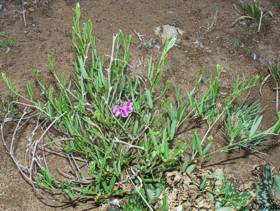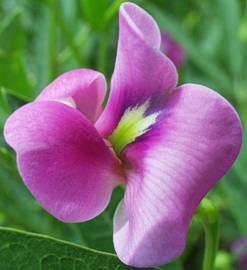Sphenostylis angustifolia
Sphenostylis angustifolia Sond.
Family: Fabaceae
Common names: wild sweet-pea (Eng.); wilde-ertjie (Afr.)
Introduction
Sphenostylis angustifolia, or the wild sweet-pea, is a lovely green perennial shrublet with an extensive woody rootstock that decorates the Highveld with its unusual pink flowers. It is one of the many so-called pre-rain flowers which start flowering in early spring irrespective of rainfall, using stored-up resources and water that the plant accumulated during the previous growing season.

Description
Description
Sphenostylis angustifolia is an attractive shrublet with annual stems 300-500 mm long from a thick and woody perennial rootstock. Stems become woody as the plant ages and are sparsely hairy, the hairs lying flat. The plant possesses an extensive and deep root system. The leaves are bright green and trifoliate, the terminal leaflet somewhat larger than the other two, with a shallowly channelled petiolule (stalk of leaflet) which is also much longer than the lateral ones; venation is very prominent below. Stipules are ovate-acuminate, small.

Flowers are relatively large, up to 20 mm long, arranged in a loose cluster at the top of the flower stalk, which is 40-80 mm long. Petals of this butterfly-flower are a bright cerise-pink, often with a whitish or yellowish centre. Pods are 80-120 mm long, dehiscing longitudinally, rendering two spirally twisted valves. Flowering time: late September to November.
Conservation Status
Status
Currently this species is not threatened.
Distribution and habitat
Distribution description
The wild sweet-pea is endemic to the northern provinces of South Africa and also occurs in Swaziland. It is a common species of the Highveld and typically occurs on rocky ridges, hill slopes and within grassland. In cultivation, this plant is suited to gardens that receive frequent frost during winter and it can be grown as part of a bed of flowers or out in the open on its own with vast amounts of natural sunlight.
Derivation of name and historical aspects
History
Sphenostylis is Greek, meaning a wedge-shaped style, and angustifolia is Latin, meaning narrow leaves. The common name of this species alludes to its sweetly scented butterfly-like flowers which is reminiscent of the garden ornamental of the same name. Sphenostylis is a small genus of about seven species that occurs only in Africa.
Ecology
Ecology
The wild sweet-pea is just one of many species of wild plants that flowers during the last weeks of winter into early spring and summer without having to wait for a drop of rain to fall.These flowers are termed pre-rain flowers and accumulate water and other resources during the previous year's growing season. Often, late winter fires act as a trigger for wild flowers of this kind to develop rapidly and flower before being engulfed by grasses, which effectively limit the chances of pollinators noticing and pollinating them.
One of the most interesting aspects of the floral anatomy of Sphenostylis angustifolia is the distinct orientation (handedness) of the style which is the female part of the plant reproductive structure. It is turned in a distinctly right- or left-handed way as it protrudes from the floral base, even forcing the keel to grow in the specific direction of orientation.

Until recently, there were only speculations as to why some plants display this orientation, which can also be seen in leaf arrangement and tendrils, but very little data has been available to back up the theories. It has since been found that there is a genetic basis for this phenomenon. This occurrence is thought to be a mechanism plants use to prevent self- fertilization. This difference in floral orientation prevents the pollen of right-handed flowers from being introduced to other right-handed flowers and vice versa for left-handed flowers. Rather, the pollination of the opposite type of flower is promoted, thus encouraging cross-pollination between plants. By preventing self- fertilization, plants increase their genetic variability which is beneficial during adverse environmental conditions and in cases of plant pathological conditions. Even though this theory holds for plants of other species, it still doesn't explain the dominance of right-handed flowers of the wild sweet-pea as observed in nature.
Uses
Use
Sphenostylis angustifolia is a good stock feed. The closely related S. marginata is used for food and for medicinal purposes. It has also been used as a fish poison in southern Zimbabwe. No medicinal or culinary uses are known for S. angustifolia; however, it has the potential to make a very interesting and colourful indigenous garden specimen. The best known species in the genus is the African yam bean (S. stenocarpa) which has a wide distribution throughout tropical Africa and is grown extensively as the seeds provide a very rich and inexpensive source of protein. The tuber of S. stenocarpa is also edible and the seeds are said to have medicinal properties.

Growing Sphenostylis angustifolia
Grow
Sphenostylis angustifolia is not often found in cultivation, even though it should make a stunning specimen in any garden. Keen indigenous plant growers, however, have been able to grow this beautiful legume and suggest that the best method is by using fresh seeds that have not been parasitized by insects.
Soak the seeds overnight in warm water and sow in a 1:1 soil mixture of sand and loam the next day. This should preferably be done during the spring months of September and October. Water regularly. When the first leaves appear, transplant either into a pot or to the plant's permanent place of residence, keeping in mind that they form extensive and thick underground rootstocks. These plants need a lot of sunlight and regular watering in the summer months to simulate their natural environment and are therefore best suited outside. During winter, the above-ground plant parts may die off although this doesn't always happen when the plant is cultivated. Either way, it is a good idea to use other plants that look good at that time of year in combination with the wild sweet-pea.
References
- Dyer, R.A. 1947. Sphenostylis angustifolia. Flowering plants of Africa 26: t. 1010.
- Germishuizen, G. & Fabian, A. 1997. Wildflowers of northern South Africa. Fernwood Press, Vlaeberg, Cape Town.
- Leistner, O.A. (ed.). 2000. Seeds plants of southern Africa : families and genera. Strelitzia 10. National Botanical Institute, Pretoria.
- Lewis, G., Schrire, B., Mackinder, B. & Lock, M. (eds). 2005. Legumes of the world. Royal Botanic Gardens, Kew.
- Letty, C. 1962. Wild flowers of the Transvaal. Wild flowers of the Transvaal Book Fund.
- Pickrell, J. 2002. Flowers with opposite styles have a fling. Science News, June 15.
- Smith, C.A. 1966. Common names of South African plants. Memoirs of the Botanical Survey of South Africa No. 35.
- Van Wyk, A.E. (Braam) & Malan, S. 1997. Field guide to the wildflowers of the Highveld. Struik, Cape Town.
- Watt, J.M. & Breyer-Brandwijk, M.G. 1962. The medicinal and poisonous plants of southern and eastern Africa, edn 2. Livingstone, Edinburgh and London.
Credits
Alicia Grobler
National Herbarium, Pretoria
December 2008
Plant Attributes:
Plant Type: Perennial
SA Distribution: Free State, Gauteng, KwaZulu-Natal, Limpopo, Mpumalanga, North West
Soil type:
Flowering season: Spring, Early Summer
PH:
Flower colour: Pink
Aspect: Full Sun
Gardening skill: Challenging
Special Features:
Horticultural zones









Rate this article
Article well written and informative
Rate this plant
Is this an interesting plant?
Login to add your Comment
Back to topNot registered yet? Click here to register.